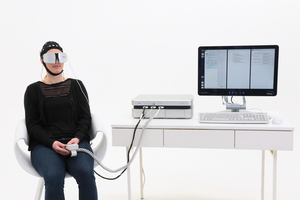BERLIN, GERMANY--(Marketwired - Jun 29, 2015) - The non-invasive EBS therapy offers patients with visual field loss an alternative treatment option. The targeted use of gentle alternating current to the damaged nerve structures in the brain causes stimulation and recovery of function. The therapy is pain-free and safe, and the effectiveness of the method has already been demonstrated in a clinical study.1
Vision is a fascinating process, which takes place not only in the eye, but also in a complex brain network, which includes the optic nerve and the visual cortex. If a stroke, a brain injury, or certain eye disorders such as glaucoma damages this visual system, the connection within the various areas is disturbed. As a result, they are no longer able to communicate with each other, leading to visual impairment.
Gentle process based on stimulation of nerve cells
EBS therapy is a completely new treatment option. It has been developed based on a proven concept in neurological practice to bring new hope to patients with visual field loss. "The benefits of alternating current stimulation have been shown neurologically, and we know that the principle works. We are currently transferring this experience to the field of ophthalmology", explains Prof. Dr. Carl Erb, glaucoma expert and medical director of the Ophthalmology Clinic at Wittenbergplatz, Berlin, Germany.
The stimulator conducts low-dose alternating current from electrodes above and below the eye to the retina. This stimulation is exactly matched to the patient's current state, and the damaged nerve structures are able to resume function. The patient perceives this response as light stimuli (phosphenes). Repeated rhythmic stimuli of neurons lead to a change in communication within the structures responsible for vision. In other words, the visual process is trained and there is a permanent learning effect in the brain.
Safe and pain-free procedure
The EBS therapy system consists of various complementary components, which include an electrical stimulator and a high-precision EEG machine. They are combined in the patient unit, to which the patient is connected via an EEG cap and special stimulation glasses. The therapist controls the progress of the treatment session through a monitoring unit.
The treatment consists of ten sessions, carried out on ten consecutive working days. One session lasts about 70-90 minutes including preparation. EBS therapy is pain-free and has no relevant side effects.
EBS therapy centers include:
- Augenklinik am Wittenbergplatz, Prof. Dr. Carl Erb, Berlin, Germany (Ophthalmology),
- Center for Vision Restoration, Dr. Anton Fedorov, Berlin, Germany (Neurology),
- MVZ an der Brandenburg Klinik, Prof. Dr. Michael Jöbges, Bernau, Germany (Neurology)
- Augenklinik MVZ, Prof. Dr. Thomas Neuhann, Munich, Germany (Ophthalmology / Neurology)
1 Fedorov A, Sabel B, Multy-center study for the treatment of patients with optical neuropathy using non-invasive altering current stimulation. ClinicalTrails.gov Identifier: NCT01280877.
About EBS Technologies
EBS Technologies GmbH, based in Hennigsdorf close to Berlin, Germany, develops software and hardware for medical stimulation therapies. The company holds several patents in the EU and the USA, and has successfully completed a clinical trial of the EBS therapy. The EBS therapy system is approved for the treatment of visual field loss in accordance with EU regulations as a medical device with a CE label. For more information on EBS Technologies, please visit: www.ebstech.eu
More information on the EBS therapy and a complete list of therapy centers is available under www.ebs-therapy.com
Contact Information:
Media contact:
BSKOM
Christine Bähren / Martina Frank
Tel: +49 89 13 95 78 27 17 /18
E-Mail: baehren@bskom.de / frank@bskom.de
